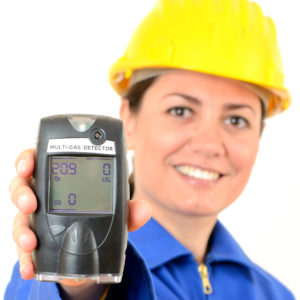
In complex industrial work environments, air quality must be monitored to not only ensure safe working conditions for employees, but also to meet company and governmental compliance requirements. In those facilities that produce hazardous gases, providing respiratory equipment alone does not provide adequate protection.
Facilities generate different gases according to the type of product being manufactured. These gases are classified into three different types or categories, and all require gas detection monitors and environmental monitoring equipment to prevent unsafe work environments.
Combustible
These gases burn if mixed with air or oxygen, or are ignited. Types of these gases include:
- Methane
- Pentane
- Propane
- Butane
- Hydrogen
Combustible gas sensors are placed in locations where there is a danger of accumulation that could create a combustible environment. It is possible to leak these gases into a facility unintentionally or naturally, which necessitates the need for monitoring. Detectors generally measure combustion concentrations from lower explosive limits (LEL) to upper explosive limits (UEL).
Asphyxiating
Although non-toxic, these gases reduce or force out the normal oxygen levels present in breathing air, and can lead to asphyxiation. Examples of these gases are:
- Nitrogen
- Argon
- Helium
- Butane
- Propane
Industries that use pressurized gas cylinders or liquefied gases stored in dewars for cryogenic storage should be especially cognizant of leaking issues due to the way these containers are typically stored–in a dedicated room or enclosed employee workspace. Oxygen deficiency monitors are commonly used in these situations.
Toxic
These gases are not only found in industrial environments, but natural ones as well. While some may contain an odor, others are odorless, colorless, and undetectable. These are examples of toxic gases:
- Carbon Monoxide
- Hydrogen Sulfide
- Solvents, like gasoline, kerosene and paint strippers
- Phosphine
- Chlorine
Toxic gas detectors allow for constant monitoring of gas concentrations in the air. Should the concentration climb, an alarm goes off. Oxygen depletion detectors are often used in conjunction with these monitors.
Fixed gas detection systems alert employees if there are catastrophic leaks or low level toxic, corrosive, or combustible gases detected in the air. Detection systems provide an early warning for potentially life-threatening situations resulting from a leak incident. Regular maintenance is required to ensure the system is providing accurate gas level information.
For more information regarding unique or specific gas leak detection equipment needs for your facility or work environment, fill out our convenient support form located on our website at https://www.windycitywebdesigns.com/clients/dod/contact-us/. A member of our team will contact you with answers to your questions.






